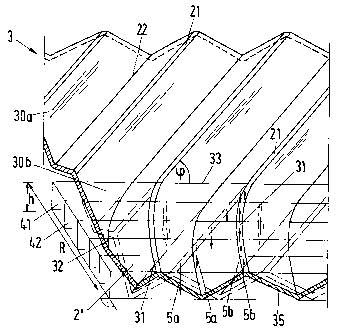Some of the information on this Web page has been provided by external sources. The Government of Canada is not responsible for the accuracy, reliability or currency of the information supplied by external sources. Users wishing to rely upon this information should consult directly with the source of the information. Content provided by external sources is not subject to official languages, privacy and accessibility requirements.
Any discrepancies in the text and image of the Claims and Abstract are due to differing posting times. Text of the Claims and Abstract are posted:
| (12) Patent: | (11) CA 2299088 |
|---|---|
| (54) English Title: | METHOD FOR SHAPING STRIP-LIKE FILMS |
| (54) French Title: | METHODE DE PROFILAGE DE BANDES DE FILM |
| Status: | Expired and beyond the Period of Reversal |
| (51) International Patent Classification (IPC): |
|
|---|---|
| (72) Inventors : |
|
| (73) Owners : |
|
| (71) Applicants : |
|
| (74) Agent: | SMART & BIGGAR LP |
| (74) Associate agent: | |
| (45) Issued: | 2004-08-10 |
| (22) Filed Date: | 2000-02-22 |
| (41) Open to Public Inspection: | 2000-10-15 |
| Examination requested: | 2000-02-22 |
| Availability of licence: | N/A |
| Dedicated to the Public: | N/A |
| (25) Language of filing: | English |
| Patent Cooperation Treaty (PCT): | No |
|---|
| (30) Application Priority Data: | ||||||
|---|---|---|---|---|---|---|
|
The method for the shaping of strip-like films (2), comprises the following steps: a) A film strip (2) is continuously forwarded from a film supply to shaping units, b) The film strip (2) is pleated in a first shaping unit (11). In this, edges (21, 22) are produced which form an angle of inclination to the edges (36) of the film strip having a constant value. c) After a forwarding of the pleated strip (2') to at least one further shaping unit (12) the former is reshaped in one or more steps. In this the edges (21, 22) are eliminated through plastic deformation by means of a roller pair (120) in edge zones (30b) outside of a middle zone (30a) of the strip and are at the same time replaced by curved edges (31, 32). The angles of inclination of the curved edges continuously increase from the middle zone to the strip edges.
La méthode pour le profilage de bandes de film (2), comprend les étapes suivantes : a) une bande de film (2) est transférée en continu à partir d'unités d'alimentation en film vers des unités de profilage. b) La bande de film (2) est plissée dans une première unité de profilage (11). Dans ce cas, les bords (21, 22) sont produits pour former un angle d'inclinaison avec les bords (36) de bandes de film présentant une valeur constante. c) Après le transfert de la bande plissée (2') vers au moins une autre unité de profilage (12) celle-là est remodelée dans une ou plusieurs étapes. Dans ce cas les bords (21, 22) sont éliminés par déformation du plastique au moyen de deux rouleaux (120) dans les zones de bordure (30b) en dehors d'une zone médiane (30a) de la bande et sont en même temps remplacés par des bords incurvés (31, 32). Les angles d'inclinaison des bords incurvés augmentent continuellement à partir de la zone médiane vers les bords de la bande.
Note: Claims are shown in the official language in which they were submitted.
Note: Descriptions are shown in the official language in which they were submitted.

2024-08-01:As part of the Next Generation Patents (NGP) transition, the Canadian Patents Database (CPD) now contains a more detailed Event History, which replicates the Event Log of our new back-office solution.
Please note that "Inactive:" events refers to events no longer in use in our new back-office solution.
For a clearer understanding of the status of the application/patent presented on this page, the site Disclaimer , as well as the definitions for Patent , Event History , Maintenance Fee and Payment History should be consulted.
| Description | Date |
|---|---|
| Time Limit for Reversal Expired | 2017-02-22 |
| Letter Sent | 2016-02-22 |
| Inactive: IPC from MCD | 2006-03-12 |
| Grant by Issuance | 2004-08-10 |
| Inactive: Cover page published | 2004-08-09 |
| Inactive: Final fee received | 2004-05-28 |
| Pre-grant | 2004-05-28 |
| Notice of Allowance is Issued | 2003-12-22 |
| Letter Sent | 2003-12-22 |
| Notice of Allowance is Issued | 2003-12-22 |
| Inactive: Approved for allowance (AFA) | 2003-12-03 |
| Amendment Received - Voluntary Amendment | 2003-09-24 |
| Inactive: S.30(2) Rules - Examiner requisition | 2003-03-31 |
| Application Published (Open to Public Inspection) | 2000-10-15 |
| Inactive: Cover page published | 2000-10-15 |
| Letter Sent | 2000-04-17 |
| Inactive: Correspondence - Transfer | 2000-04-06 |
| Inactive: IPC assigned | 2000-04-04 |
| Inactive: First IPC assigned | 2000-04-04 |
| Inactive: Courtesy letter - Evidence | 2000-03-21 |
| Filing Requirements Determined Compliant | 2000-03-17 |
| Inactive: Filing certificate - RFE (English) | 2000-03-17 |
| Application Received - Regular National | 2000-03-15 |
| Inactive: Single transfer | 2000-03-09 |
| Request for Examination Requirements Determined Compliant | 2000-02-22 |
| All Requirements for Examination Determined Compliant | 2000-02-22 |
There is no abandonment history.
The last payment was received on 2004-01-16
Note : If the full payment has not been received on or before the date indicated, a further fee may be required which may be one of the following
Please refer to the CIPO Patent Fees web page to see all current fee amounts.
Note: Records showing the ownership history in alphabetical order.
| Current Owners on Record |
|---|
| SULZER CHEMTECH AG |
| Past Owners on Record |
|---|
| BAR MARTIN |